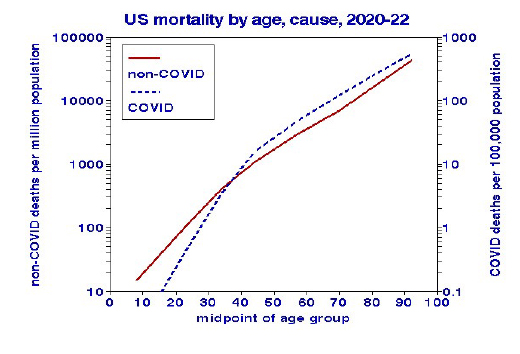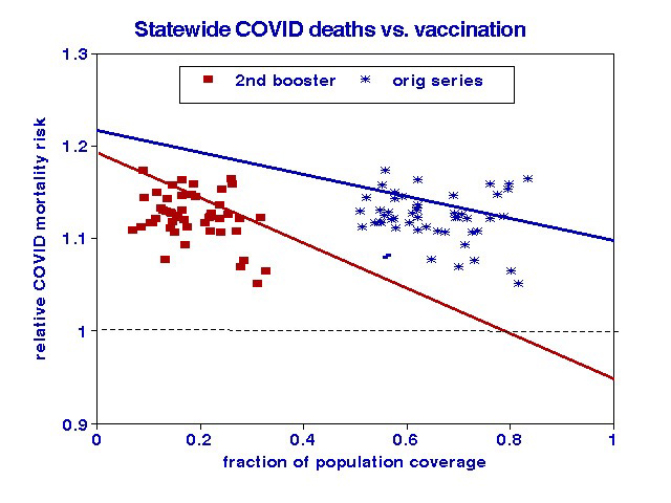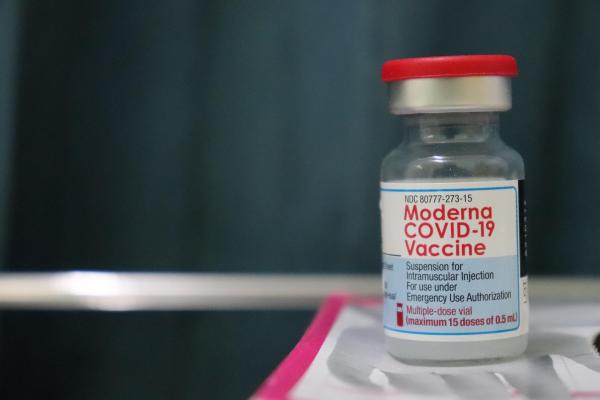“Vaccination is highly effective in preventing severe COVID-19 illness and death.”
Jennifer Kriss, Ph, D Epidemiologist at Centers for Disease Control [2]
Health effects on the elderly have been emphasized during the pandemic; however, such health effects, especially mortality, tend to be higher for all causes, not just COVID. In this analysis, we focus on differences between COVID and non-COVID deaths, expressed as relative risk ratios of COVID mortality, where non-COVID deaths are defined as total death counts less COVID death counts. The pandemic may have also increased non-COVID deaths by virtue of treatment delays. [3]
Mortality rates have typically been compared using logarithmic scales, the slopes of which are referred to as  Gompertz coefficients, which are about 0.08 for many countries and conditions. We found similar coefficients for U.S. COVID and non-COVID deaths. Note that these mortality rates differed almost 10-fold and were thus plotted on separate scales, but their Gompertz coefficients are essentially identical above about age 50.
Gompertz coefficients, which are about 0.08 for many countries and conditions. We found similar coefficients for U.S. COVID and non-COVID deaths. Note that these mortality rates differed almost 10-fold and were thus plotted on separate scales, but their Gompertz coefficients are essentially identical above about age 50.
 We found that the COVID mortality risk relationships with age changed over time and used statistical curve-fits to illustrate them. They show that age effects were stronger in 2020 and that mortality risks were relatively lower in 2021 and peaked at lower ages. These shifts may have been influenced by the different coronavirus variants that emerged during the pandemic. However, the elderly did not bear the highest relative mortality risks after 2020.
We found that the COVID mortality risk relationships with age changed over time and used statistical curve-fits to illustrate them. They show that age effects were stronger in 2020 and that mortality risks were relatively lower in 2021 and peaked at lower ages. These shifts may have been influenced by the different coronavirus variants that emerged during the pandemic. However, the elderly did not bear the highest relative mortality risks after 2020.
Because of administrative protocols, vaccination rates are highly dependent on age. Booster shots were limited to those who completed the 2-shot original (full) series, and access to the second booster was limited to those who received the first booster.
 The age-trend lines convey various messages.
The age-trend lines convey various messages.
- Maximum coverage of the original series peaked at age 70 but not for the very elderly and ostensibly most vulnerable.
- Rates of change have slowed to a crawl.
- Coverage of the booster shots is inexorably lower because of the age-dependent eligibility rules. (Rates for the first booster shots are shown as percentages of the original series.)
- The second booster shot coverage, for which we had limited data, is based on the entire population.
At best, with 80% coverage at each stage of vaccination and the two boosters, the resulting population coverage would be 51% (80% x 80% x 80% = 51%), and even lower for those middle-aged.
The relative risk of COVID mortality with age
We limited the analysis to four age groups: 55-64, 65-74, 75-84, and 85+, from January 1, 2020, through May 22, 2022.[1]
- There were 860,000 COVID and 5.95 million non-COVID deaths during this period.
- The mean (unweighted) relative COVID risks for the four groups were 1.156, 1.168, 1.149, and 1.124.
- Since these age effects were minor, we averaged the four groups and focused on relationships between relative risks and vaccination rates in the aggregate, based on state-level data.
We plotted these average relative risks against percentages of populations covered by the original “full” series and the second boosters – comparing relative cumulative mortality risks with vaccination coverage after accounting for age. For clarity, we omitted the intermediate data from the first booster shots. This analysis tested the ability of increased vaccination doses to predict a given set of mortality risks and estimated likely outcomes at 100% vaccination coverage. Age had a slight negative but statistically significant effect on relative risks of COVID mortality.
The vaccination data with the booster fit the relative risk data much better than the original series of two shots, with the regression predicting essentially no mortality risk at 100% booster coverage, assuming that present conditions persist. Given the likelihood of new variants during the time required to achieve that level of coverage, this assumption is unlikely.

We drew several conclusions from this analysis:
- Using COVID mortality relative risks removed the typical exponential mortality relationship with age.
- The relative risks of COVID mortality varied with age and changed during the pandemic.
- There is limited data on usage of the second booster shots, but their relationships with age were similar to those for the original series and the first boosters.
- Data on booster shot coverage are much better predictors of state-level mortality risks than data from the original vaccination series.
- Each percentage point in the first booster shot coverage was associated with about 0.2% or about 1700 COVID deaths.
Without vaccinations, COVID deaths would have exceeded non-COVID deaths by about 25%, about 1.5 million MORE deaths for the entire pandemic.
[2] MMWR June 10, 2022
[3] Non-Covid Excess Deaths, 2020-21: Collateral Damage of Policy Choices? NBER Working Paper 30104,



